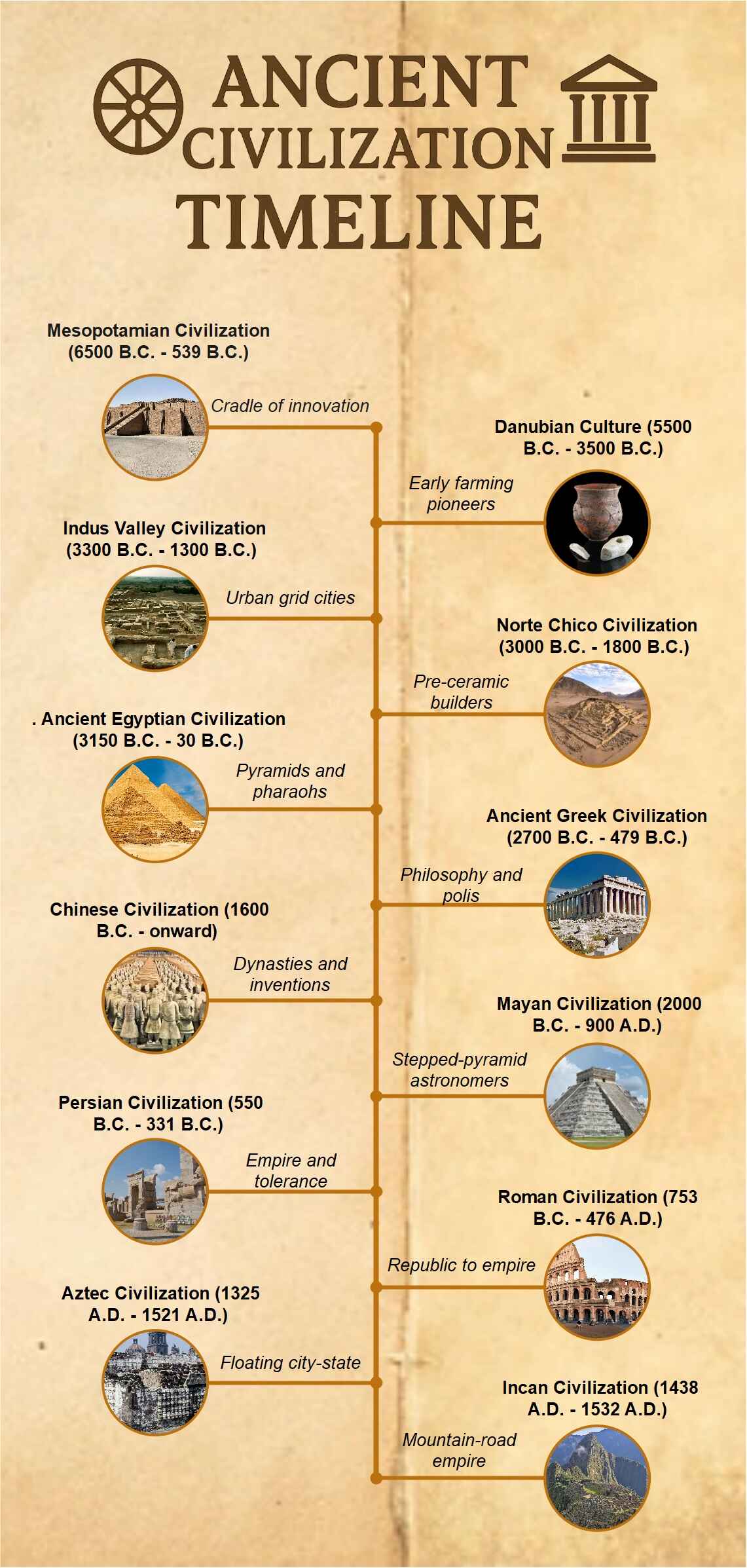History isn’t just about famous rulers or epic battles; it begins with the very first steps toward organized society. Long ago, ancient peoples were creating laws, planting crops, and marking time with calendars. They constructed cities, built governments, and explored early science and art.
These societies didn’t form overnight. They took shape over centuries in places like Mesopotamia, the Nile Valley, and the Indus region. Each added its own unique chapter to human development. Let's take a closer look at the ancient civilization timeline to understand how human history began and evolved.
In this article
Ancient Civilizations Timeline
The start of civilization goes back to about 6500 B.C. in places such as Mesopotamia and the Indus Valley. People in these early societies built cities, developed writing, and learned how to farm. From the tall ziggurats of Sumer to the famous Machu Picchu in the Andes, each culture made its own unique mark.
To understand our world today, we have to look back at where it all began.
Mesopotamian Civilization (6500 B.C. - 539 B.C.)
Mesopotamia is where it all began. It’s called the “Cradle of Civilization” for a reason. This place, between the Tigris and Euphrates rivers, gave us the first cities, writing called cuneiform, and even the wheel. That’s pretty amazing for something that started over 6,000 years ago.
It wasn’t just one group living there. The Sumerians, Akkadians, Babylonians, and Assyrians all added their parts. They built big temples called ziggurats, traded with neighbors, and created early laws. A lot of what we do today started with them.
Danubian Culture (5500 B.C. - 3500 B.C.)
Danubian culture may not be famous, but it’s very important. These early farmers lived near the Danube River in Eastern Europe. They built thousands of small villages and made beautiful pottery with spiral and striped patterns.
They also made small goddess statues, which might mean women had important roles. They were one of the first to work with gold. Even without big cities or empires, they helped build the base for European culture.
Indus Valley Civilization (3300 B.C. - 1300 B.C.)
The Indus Valley Civilization was really advanced for its time. They built planned cities with straight streets and indoor plumbing. Cities like Mohenjo-Daro and Harappa had drainage systems that were super smart.
Their writing is still a mystery because no one has cracked the code yet. It looks like they didn’t have kings or big wars. They just lived in well-organized, peaceful towns. It’s one of history’s biggest puzzles.
Norte Chico Civilization (3000 B.C. - 1800 B.C.)
Norte Chico is not well-known, but it’s one of the oldest civilizations in the Americas. They didn’t have writing or pottery, but they built huge pyramids and big plazas.
They also figured out how to farm using irrigation in the desert. There’s no sign of war or much art or religion. They mostly focused on building and surviving. This shows civilizations don’t always need all the usual stuff to be complex.
Ancient Egyptian Civilization (3150 B.C. - 30 B.C.)
Ancient Egypt is famous for pyramids, mummies, and pharaohs. It all started along the Nile River, which flooded regularly and made farming easy. That helped them build a strong and long-lasting civilization.
They believed in many gods and the afterlife. Their math, medicine, and art were very advanced. The pyramids were giant tombs built to help pharaohs get to the afterlife. Even now, Egypt’s history attracts millions of visitors.
Ancient Greek Civilization (2700 B.C. - 479 B.C.)
Ancient Greece gave us lots of important things like democracy, philosophy, and the Olympics. Athens was a city that loved thinking and politics, while Sparta was all about training strong warriors.
They cared about art, science, and stories. Famous thinkers like Socrates, Plato, and Aristotle still matter today. Their ideas influence governments, buildings, and how we ask big questions about life.
Chinese Civilization (1600 B.C. - onward)
China is one of the oldest civilizations that still exists today. It began with the Shang Dynasty along the Yellow River. They invented writing, silk, and bronze tools very early on.
Many dynasties came and went, but the culture kept growing. Think of Confucius, the Great Wall, paper, and the compass. China’s long history has shaped much of the world we know now.
Mayan Civilization (2000 B.C. - 900 A.D.)
The Maya were amazing at math, astronomy, and building big cities. They made very accurate calendars and built huge stone cities deep in Central America’s jungles. Places like Chichen Itza still impress visitors today.
They wrote in hieroglyphs and tracked stars, but they also practiced human sacrifice. Around 900 A.D., many cities were abandoned. But Maya culture didn’t disappear. Their descendants still live in Mexico and Central America.
Persian Civilization (550 B.C. - 331 B.C.)
The Persian Empire was one of the largest ever. It stretched from the Middle East to parts of India and North Africa. What’s cool is they let people keep their own cultures and religions.
Kings like Cyrus and Darius built roads, postal systems, and grand palaces. Their religion, Zoroastrianism, introduced ideas like heaven, hell, and one god. Persia was conquered by Alexander the Great, but its influence lasted long.
Roman Civilization (753 B.C. - 476 A.D.)
Rome started small but became a huge empire. Their army, engineering, and laws were the best in the world. They built roads, aqueducts, and the famous Colosseum.
Latin, their language, influenced many languages today. Rome grew too big and faced problems, leading to its fall in 476 A.D. Still, Roman ideas about law and government shape our world.
Aztec Civilization (1325 A.D. - 1521 A.D.)
The Aztecs built their capital, Tenochtitlan, on a lake. It had temples, canals, and floating gardens. They were fierce warriors and believed human sacrifice pleased their gods.
They ruled a big empire in central Mexico. But when the Spanish arrived, their empire quickly fell. Disease and conquest ended them by 1521. Aztec culture still plays a big part in Mexican identity today.
Incan Civilization (1438 A.D. - 1532 A.D.)
The Inca ruled high in the Andes Mountains. They didn’t use wheels or writing, but they built roads, bridges, and terraces for farming. Machu Picchu is their most famous site today.
They kept records with knotted cords called quipus. When the Spanish came, the empire fell fast. But the Inca left behind amazing engineering and a strong cultural legacy in South America.
How to Make Ancient Civilizations Timeline in EdrawMax?
It’s much more fun to learn about ancient civilizations when you have everything in one place. Instead of reading lots of pages and trying to keep track of dates, you can build a cool timeline.
EdrawMax is a comprehensive timeline software. I’ll guide you step by step to make your Ancient Civilizations Timeline with EdrawMax.
Step1Login & Create a New File
- Download and install EdrawMax.
- Open it and sign in with your Wondershare ID or linked social account.
- In the left sidebar, click Home, then choose Basic Diagram from the top blue bar.
- Select Timeline to see ready-made designs, or type timeline in the top-right search box to find them quickly.
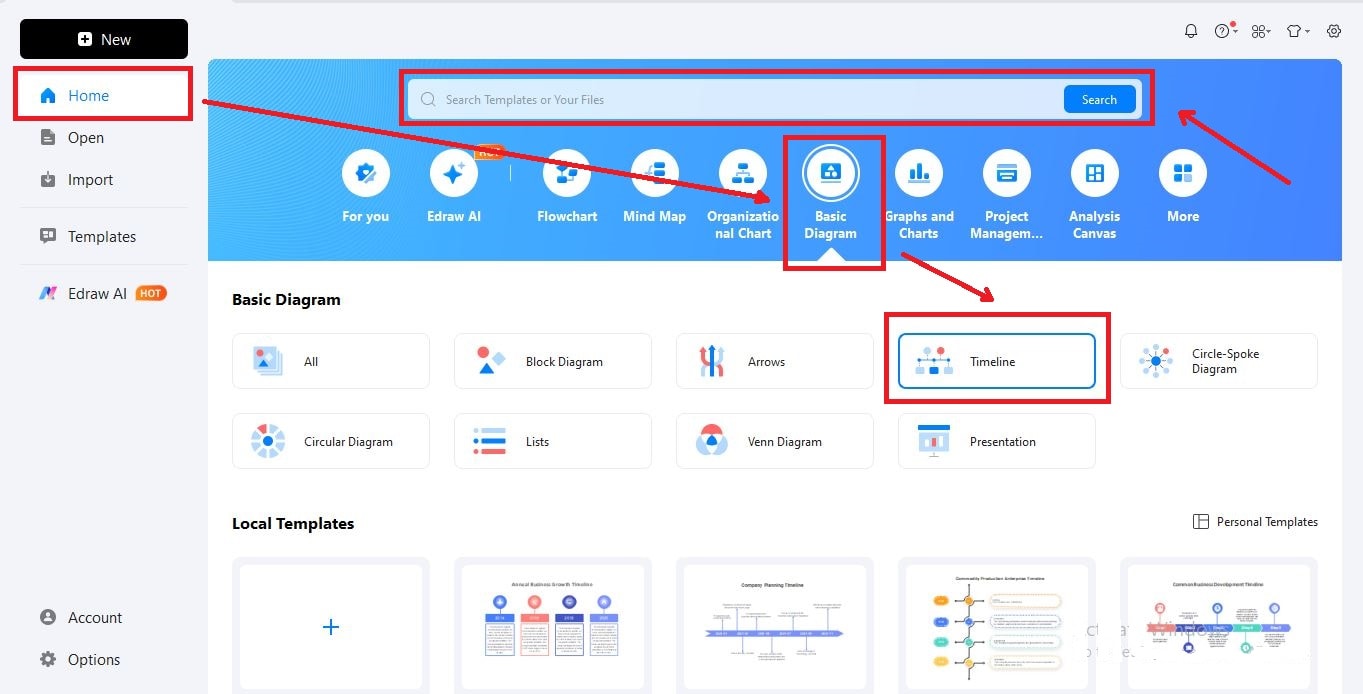
Step2Choose a Template
- In Local Templates, you’ll see different timeline styles.
- Choose one that fits your idea, such as horizontal, vertical, or circular. For example, you might pick a style for eras such as Mesopotamia, Egypt, and Indus Valley.
- Or select Blank Drawing to start fresh.
- Double-click your choice to open it.
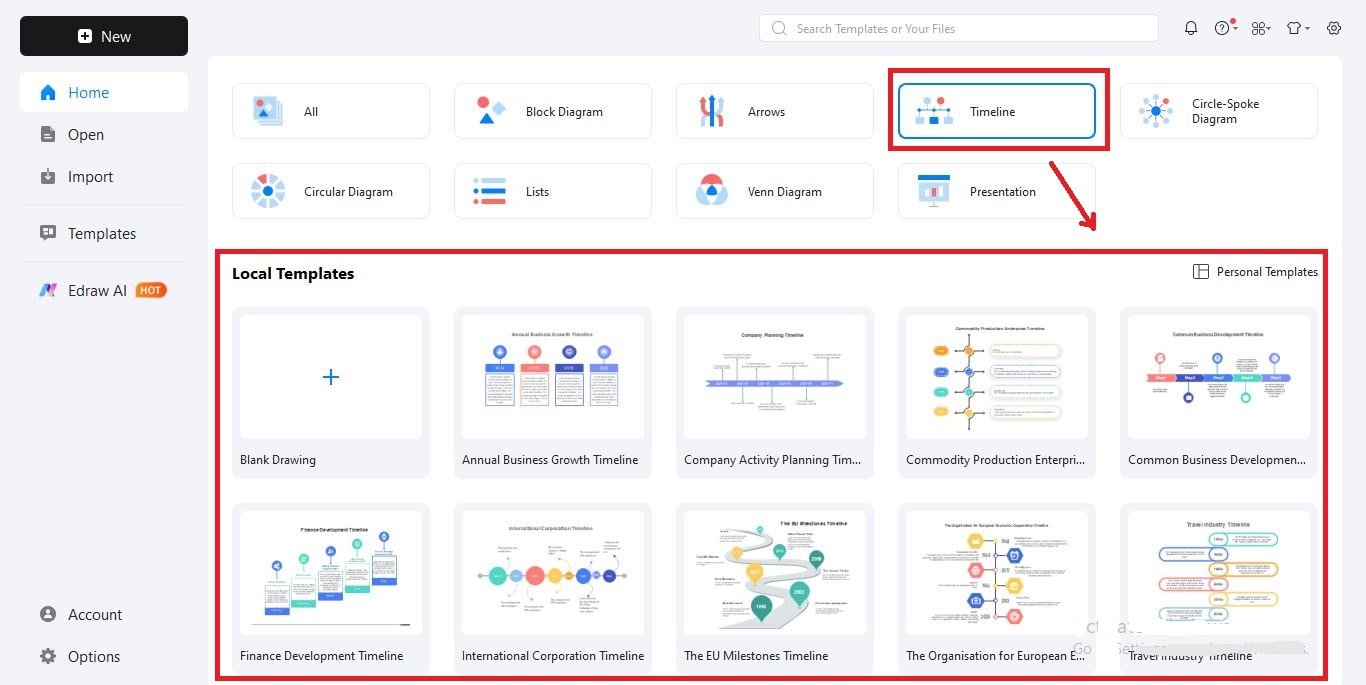
Step3Add a Title and Event Text
- Go to the Home tab at the top and click Text.
- Write a bold title like “Timeline of Ancient Civilizations.”
- Click on any text in the template and replace it with your own dates and events (e.g., “Danubian Culture (5500 B.C. - 3500 B.C.”).
- Double-click any label to edit, and use the floating toolbar to adjust font, size, color, and alignment.
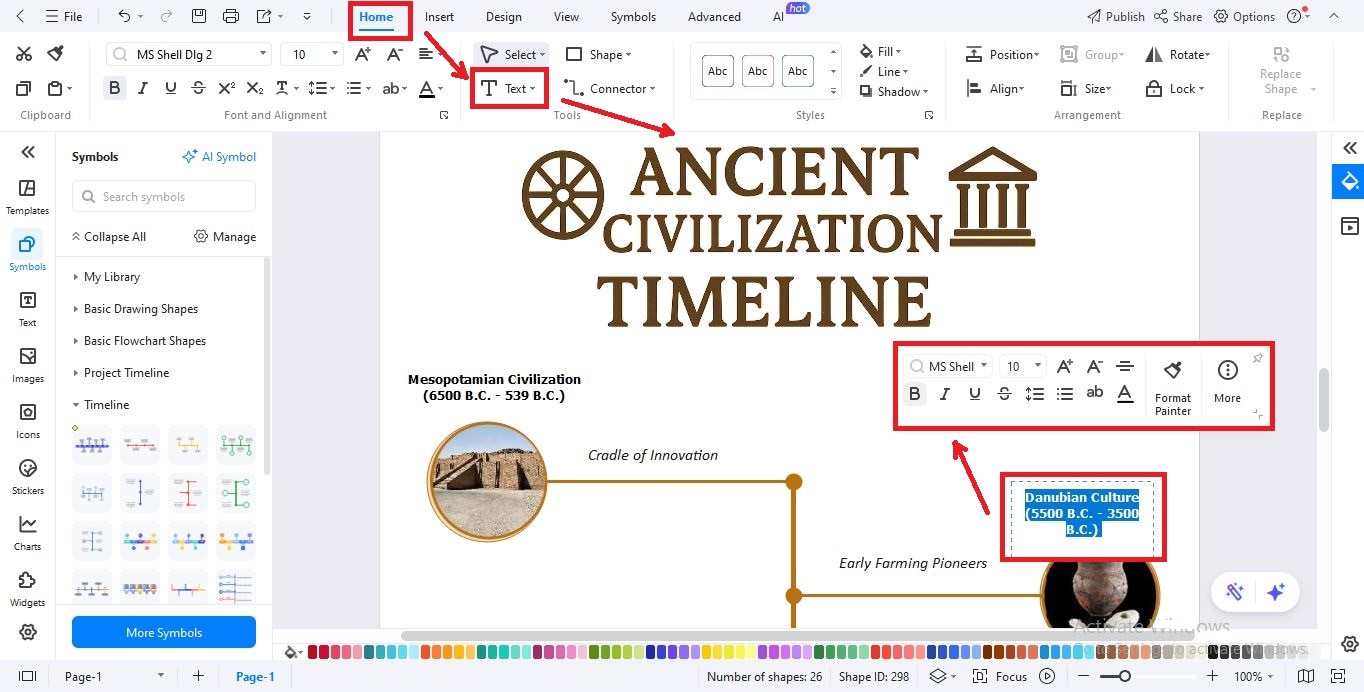
Step4Arrange and Link Events
In the Home tab:
- Use Select to move things around.
- Click Text to add new labels for more events.
- Use Shape to make boxes or callouts for important moments like “Building of the Pyramids.”
- Click Connector to draw lines between related events.
From the left toolbar, you can also add pictures, icons, maps, or symbols to make it look more interesting.
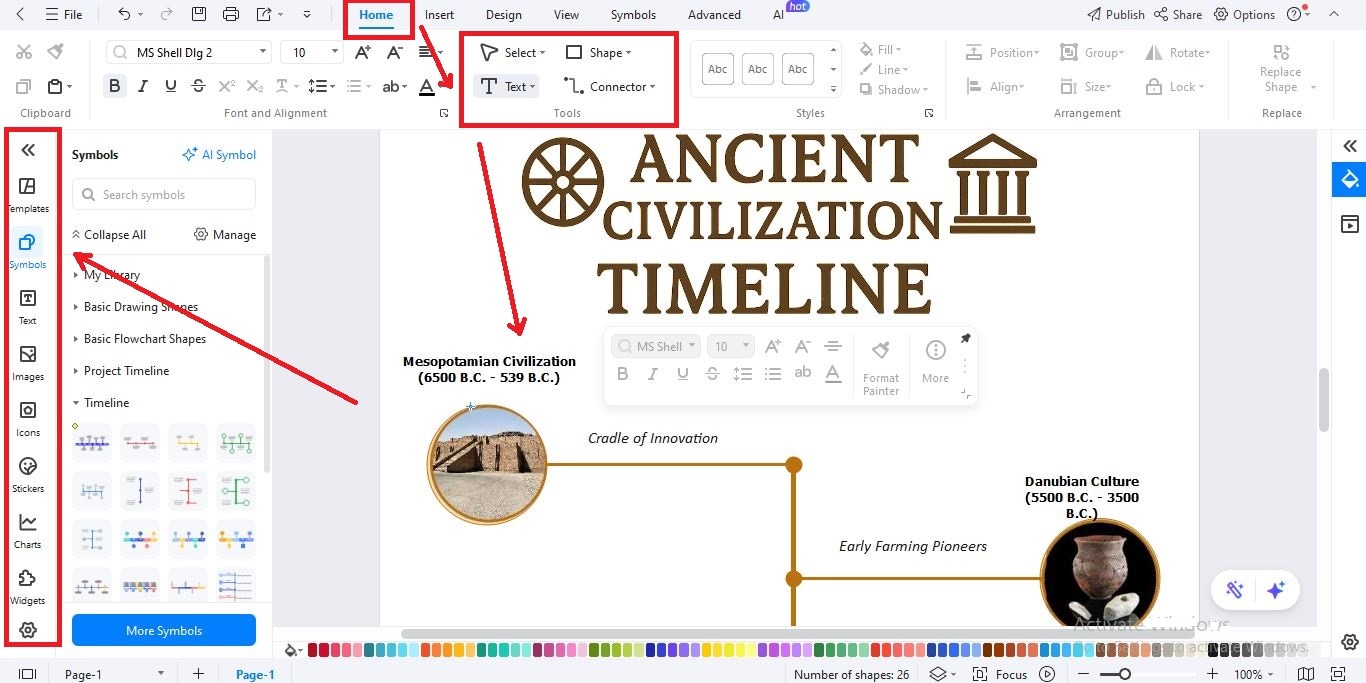
Step5Customize Timeline Design
- Select any object, then use the Styles toolbar to change Fill, Line, and Shadow.
- Use the bottom color palette to apply earthy tones for a historical feel.
- In the Home tab, use Position, Align, Size, Group, Rotate, or Lock to refine layout.
- In the Symbols panel (left), click More Symbols for extra decorative elements.
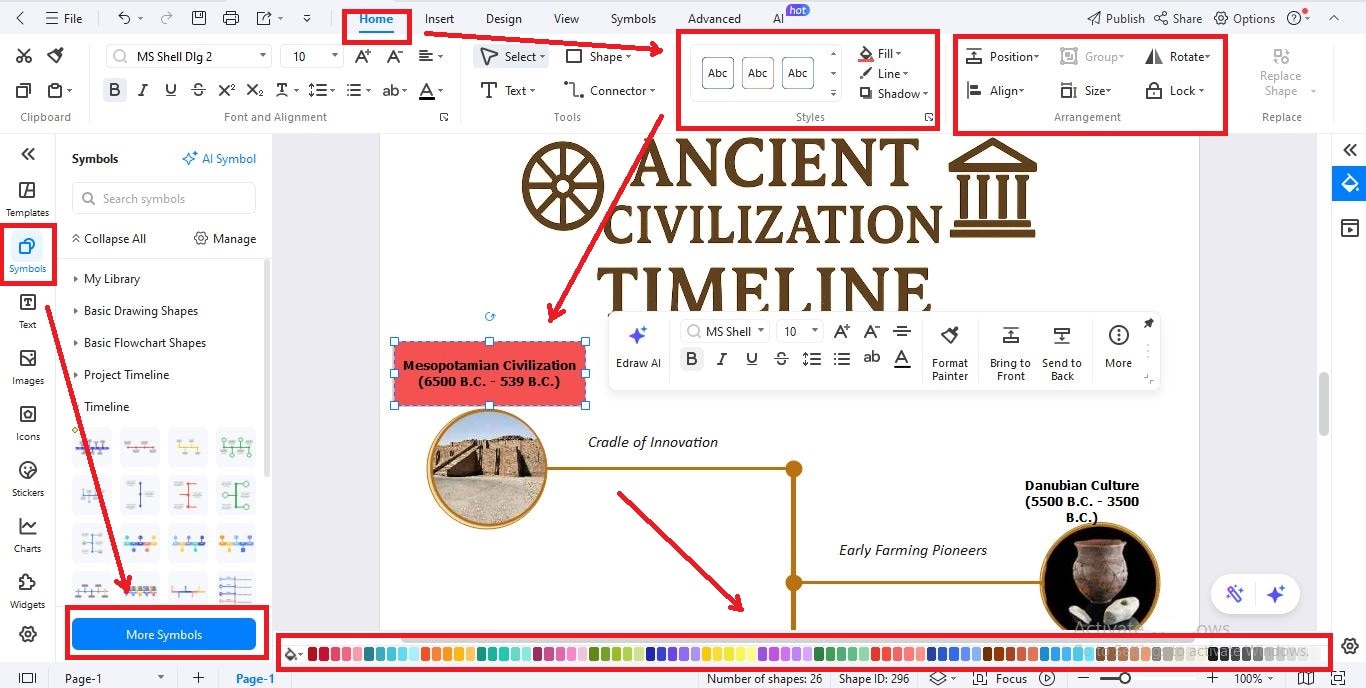
Step6Add a Background Image
- Go to Insert > Picture to add a background image from your files or EdrawMax’s library.
- On the floating toolbar, choose Send to Back, then lower opacity in Adjust.
- Right-click, select Move to Layer, and lock it.
- Pro Tip: You can also paste images directly from Google.
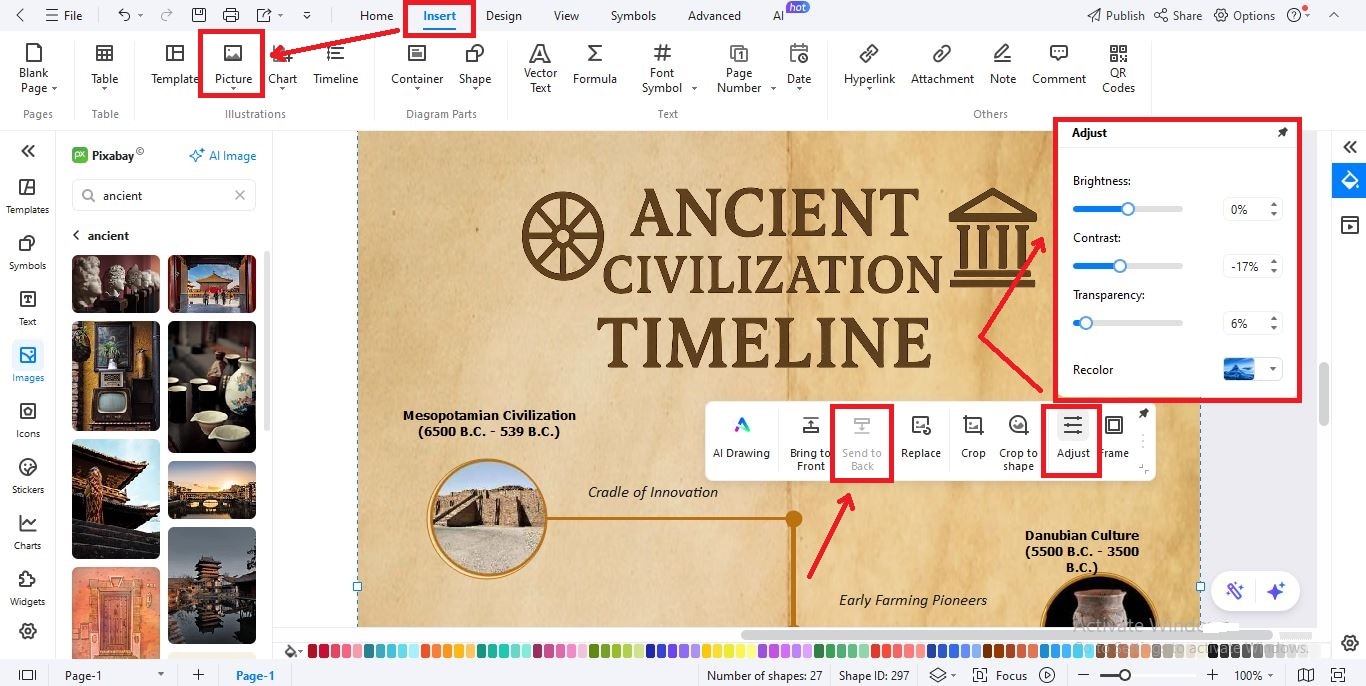
Step7Save, Share, or Export Your Timeline
- In the File menu (top-left), click Save to keep an editable copy.
- Click Share (top-right) to send it to others.
- For exports, go to File > Export and choose PNG, PDF, SVG, HTML, Visio, or Excel.
- Or click Publish, to publish it directly to the EdrawMax community to showcase your Ancient Civilizations Timeline.
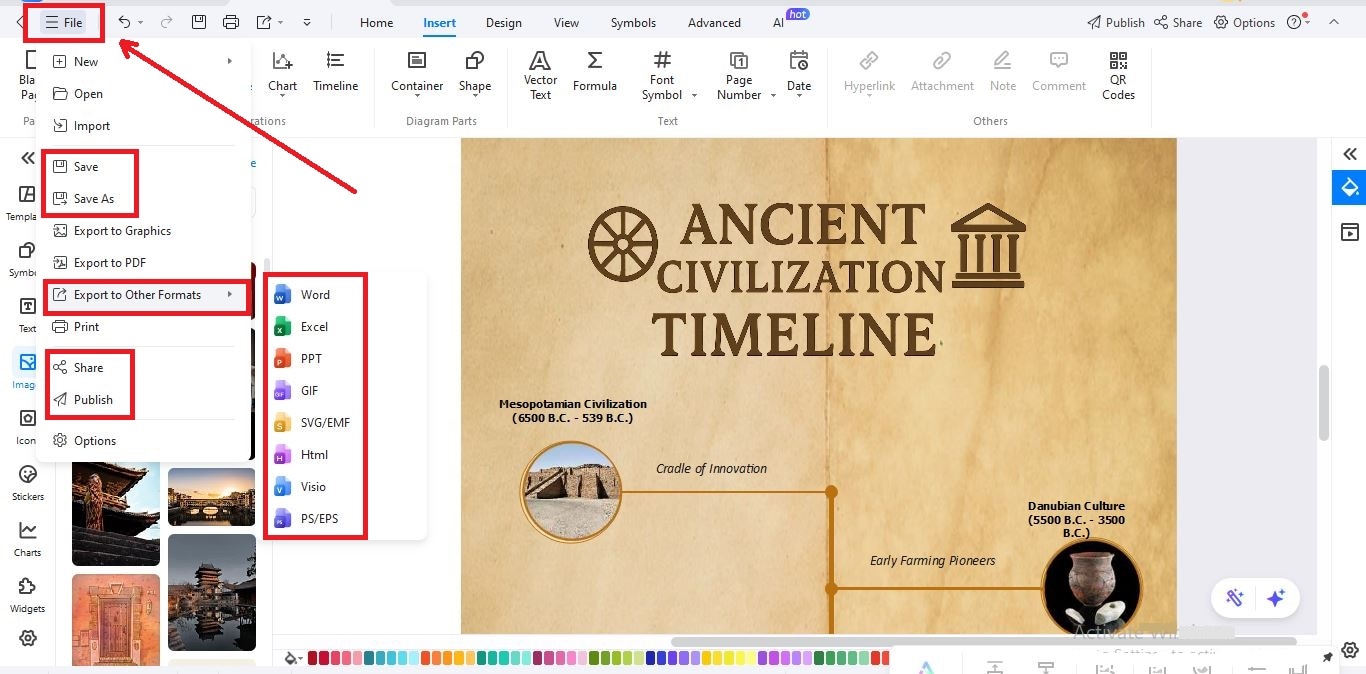
Final Thoughts
The stories of ancient civilizations show how people worked hard to build communities and share ideas. They created important inventions, such as writing, laws, and art, that shaped the future. Every civilization contributed something valuable. Learning about them helps us understand our roots and how society has changed.
If you want to understand history better and finish your projects faster, try using EdrawMax. It’s an easy tool to create timelines and mind maps. You can see all the important facts clearly without feeling confused.




